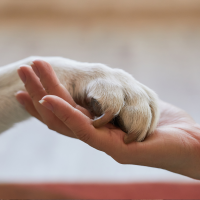What is a microchip?
Today, microchip technology is found everywhere, from computers and cell phones, to implants in wild animals for tracking of their movements, to pet microchips that provide identification information. Different types of microchips work in different ways, depending on their purpose.
The purpose of microchips used for pets is to provide a form of permanent identification. These microchip implants are called radio frequency identification (RFID) tags. They are tiny, about the size of a large grain of rice, and are passive. This means they passively store a unique identification number and do not actively transmit any information. The microchip implanted in your pet has no battery and no internal power source, so it sits inertly in the pet until it is read by a microchip scanner.
How is the microchip put into my pet?
Before insertion, the sterile microchip is scanned in the package to confirm that the identification code of the transponder is the same as that shown on the package barcode label.
The needle containing the microchip is loaded into the application gun or syringe, and your pet is positioned for the injection. For most pets, the standard site for microchip placement is in the subcutaneous tissue along the dorsal midline (the spine) between the dog’s shoulder blades. For correct placement, your pet should be either standing or lying on his stomach. Some of the loose skin between the shoulder blades is gently pulled up, and the needle is quickly inserted. The applicator trigger is squeezed, injecting the microchip into the tissue.
After insertion, the pet is scanned to ensure that the chip is reading properly.
Is it painful to insert the chip?
The procedure is fast, safe, and relatively pain-free. The chips are usually inserted without incident, even in the tiniest puppies. The application needle is large, and some clients will choose to have the microchip implanted at the time of spaying or neutering, so that the pet can be anesthetized for the injection. However, this is not necessary, and the microchip can be implanted at any time that is convenient.

Is there anything else I have to do?
Once your pet is microchipped, you must register your pet along with your name and contact information with the appropriate agency. A veterinarian or vet technician at Snodgrass Veterinary Medical Center will provide you with the relevant documents and contact information. Failure to register your pet’s microchip identification will render the entire process useless, as the microchip number will not be associated with anyone.
If you move or change your contact information, be sure to update your pet’s microchip information. If your pet is lost and recovered, this information is necessary to reunite you with your pet.
How is the microchip detected?
The microchip can be ‘read’ with a microchip scanner, which detects the specific electronic code embedded in the chip and displays the identification number on the scanner’s screen.
Since the occasional microchip may migrate, or move out of position, the microchip reader will be passed over the entire body of the pet in order to ensure that the chip is detected if present.
“Most, if not all, humane societies and animal shelters now have universal microchip readers, and routinely scan all stray and injured animals.”
Most, if not all, humane societies and animal shelters now have universal microchip readers, and routinely scan all stray and injured animals. Steps are being taken to standardize the readers and develop databases that can be readily accessed.
My pet always wears a collar with identification tags. Isn’t that enough?
Unfortunately, collars can break, fall off, or be removed. When identification tags are new, they are easy to read. However, as they get old and worn, it can become challenging to make out all the information that is on them.
Microchips cannot be misread, and the identification number is tamper-proof. The information about the pet and owner is usually readily retrievable from the database.
To set up an appointment for your pet to be microchipped, call Snodgrass Veterinary Medical Center at 270-781-5041 or click here.
© Copyright 2019 LifeLearn Inc. Used and/or modified with permission under license.






